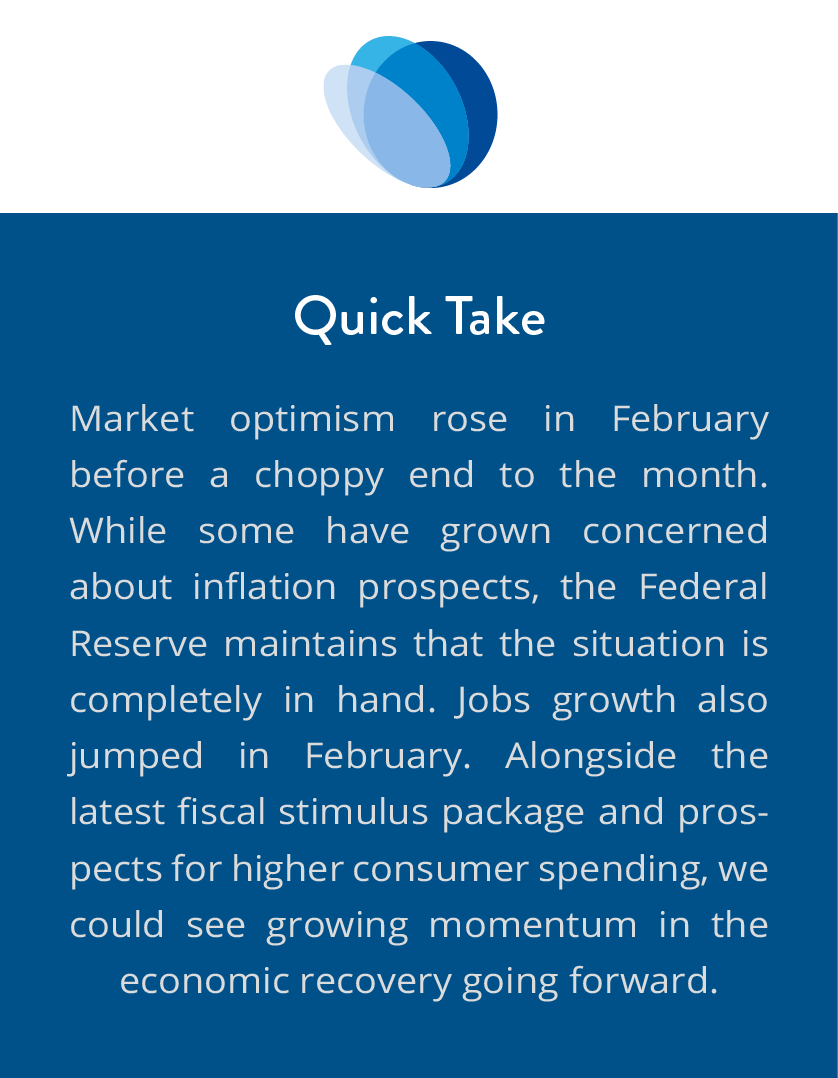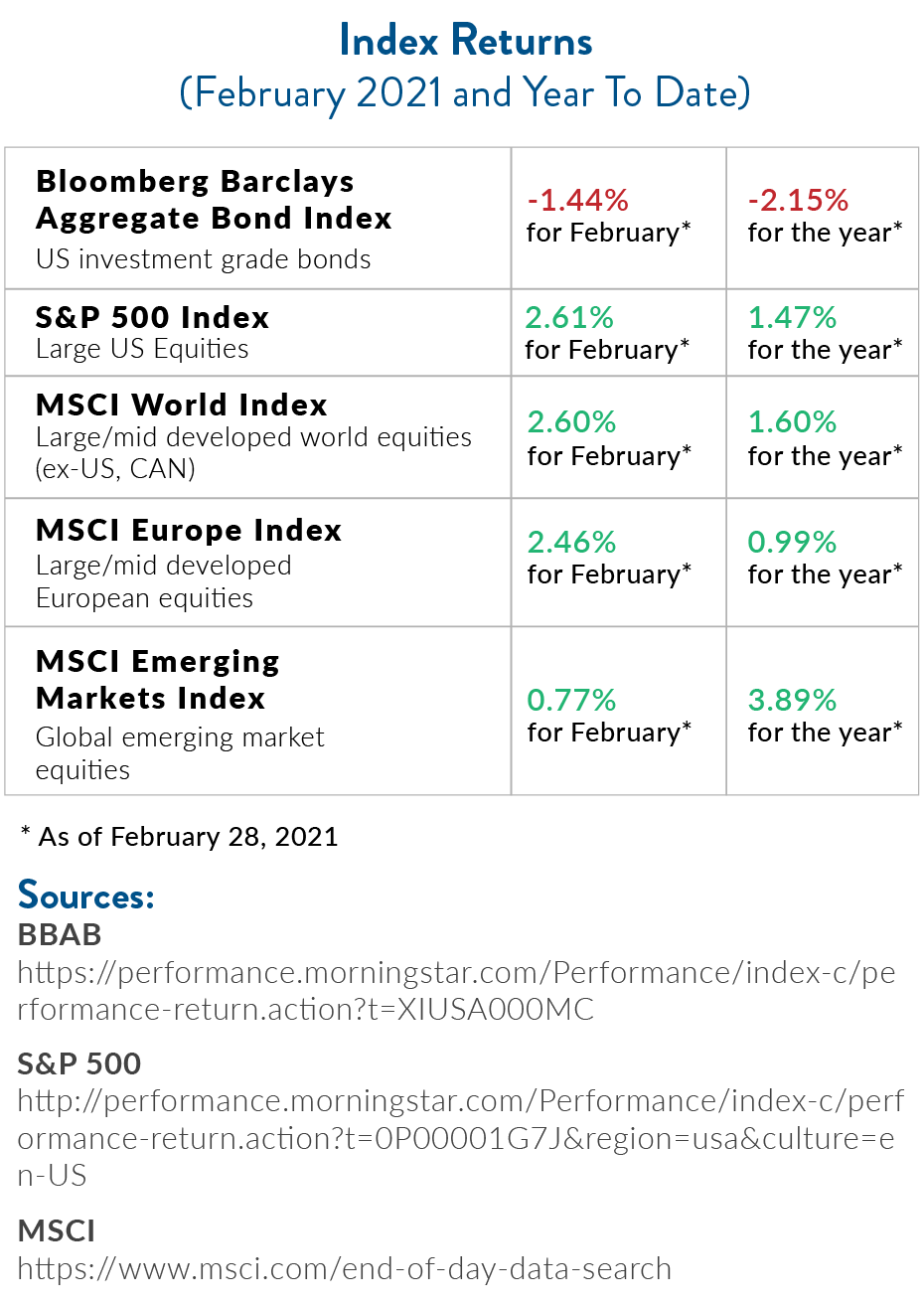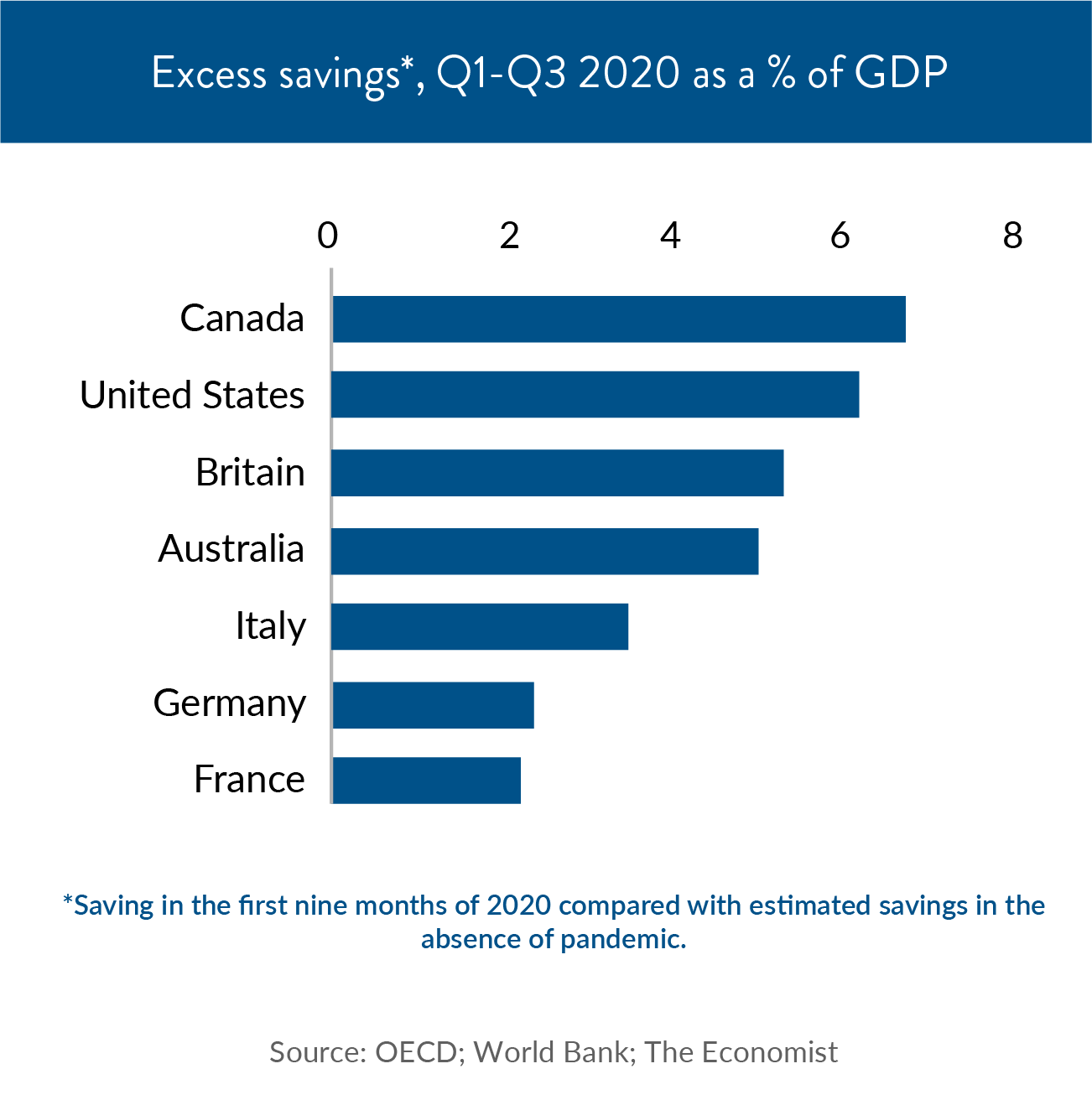Growing Momentum in the Economy
It is hard to believe that we’ve been dealing with the pandemic for an entire year. Just over a year ago, shelter-in-place orders went into effect in California—today, businesses are starting to reopen their doors and traffic is returning. By the end of February, over 239 million COVID-19 vaccines had been administered worldwide and President Biden’s additional fiscal stimulus plan was in view.
 In this article, we’ll take a look at some key drivers of the news this past month and a few variables to watch as the world begins to open up again.
In this article, we’ll take a look at some key drivers of the news this past month and a few variables to watch as the world begins to open up again.
Inflation Concerns
With optimism rising, equity markets reached new highs in February before dropping late in the month. The combination of rising bond yields, concerns about inflation, and a shift away from “stay-at-home” technology stocks drove some of this movement.[1]
The 10-year Treasury reached its highest level in over a year in February[2] before settling back down, driving numerous discussions in the financial press about the possibility of higher inflation and higher interest rates. Some economy watchers are concerned about rising global costs of production, high government debt, and a rebound in prices (particularly commodities) driving higher inflation in the future.[3] Some are concerned that inflation could expand to levels that would be difficult to reverse.
 With all that said, rising inflation expectations also breed optimism about economic growth. Indeed, the Federal Reserve has stated that a stronger outlook is driving rising yields, which are not a cause for concern on their own.[4] Fed Chair Jerome Powell also reiterates that the Federal Reserve is willing to accept slightly higher inflation in order to help get the economy back on firm footing post-pandemic.
With all that said, rising inflation expectations also breed optimism about economic growth. Indeed, the Federal Reserve has stated that a stronger outlook is driving rising yields, which are not a cause for concern on their own.[4] Fed Chair Jerome Powell also reiterates that the Federal Reserve is willing to accept slightly higher inflation in order to help get the economy back on firm footing post-pandemic.
Jobs Recovery
Jobs growth exceeded expectations in February, with 379,000 new jobs added to the economy versus the projected 200,000.[5] This was fueled by the leisure and hospitality sectors, which added 355,000 jobs. The unemployment rate fell to 6.2%; the broader U-6 unemployment rate, which includes underemployed individuals and those who have given up in their job search, held steady at 11.1%.
Considering vaccinations, fiscal stimulus, and reopenings, Fed Chair Powell expects further gains in jobs growth, though again, the Fed is heavily focused on encouraging a return to full employment within the economy. As of February, the number of unemployed people is still nearly double that of pre-pandemic levels.
Consumer Spending
When it comes to consumer spending, a significant driver of economic growth in the U.S., outlooks might be even stronger. American households have accumulated a significant amount of cash—at this point, excess savings (or the level of households above the expected norm) could soon exceed 10% of GDP.[vi]
 Wealthier households possess most of this cash; however, as a percentage of income, lower-income households perhaps saved even more than their more affluent counterparts. One study found that the most needy Americans had bank balances about 40% higher in December 2020 than in the year prior, compared to just 25% higher for the wealthiest individuals.
Wealthier households possess most of this cash; however, as a percentage of income, lower-income households perhaps saved even more than their more affluent counterparts. One study found that the most needy Americans had bank balances about 40% higher in December 2020 than in the year prior, compared to just 25% higher for the wealthiest individuals.
This may impact spending growth—depending, of course, on how households perceive their additional wealth. Generally speaking, people are more willing to spend savings when it feels like a part of their income, rather than their long-term wealth. That said, we think there is also the possibility that some of those additional savings, especially among lower earners, may need to be deployed back to debt service, basic needs, or as a backstop in case of additional economic surprises.
 Of course, we’ll see how this plays out, but we do think it’s likely that something of a consumer spending boom will occur in the coming year as we venture back out into the world.
Of course, we’ll see how this plays out, but we do think it’s likely that something of a consumer spending boom will occur in the coming year as we venture back out into the world.
Don’t Forget to Join Our Webinars
We enjoyed a great webinar on March 9th with John Wiley from Franklin Templeton. He shared pertinent thoughts about the municipal bond market and the opportunities and risk factors investors should keep in mind going forward. If you missed it, be sure to reach out to our office to learn more.
Overall, we have been thrilled to see such amazing turnout for these events, and there are many more exciting topics and speakers to come. Keep an eye out for your invitation to our upcoming webinar on ESG investing (sometimes described as sustainable or socially responsible investing) later this month.
We look forward to seeing you there!
Download print version of this article
The information expressed herein are those of JSF Financial, LLC, it does not necessarily reflect the views of Mid Atlantic Capital Corporation (MACC). Neither JSF Financial LLC nor MACC gives tax or legal advice. All opinions are subject to change without notice. Neither the information provided, nor any opinion expressed constitutes a solicitation or recommendation for the purchase or sale of any security. Investing involves risk, including possible loss of principal. Indexes are unmanaged and cannot be invested in directly.
Historical data shown represents past performance and does not guarantee comparable future results. The information and statistical data contained herein were obtained from sources believed to be reliable but in no way are guaranteed by JSF Financial, LLC or MACC as to accuracy or completeness. The information provided is not intended to be a complete analysis of every material fact respecting any strategy. The examples presented do not take into consideration commissions, tax implications, or other transactions costs, which may significantly affect the economic consequences of a given strategy. Diversification does not ensure a profit or guarantee against loss. Carefully consider the investment objectives, risks, charges and expenses of the trades referenced in this material before investing.
Asset Allocation and Diversification do not guarantee a profit or protect against a loss.
The Bloomberg Barclays U.S. Aggregate Bond Index measures the investment-grade U.S. dollar-denominated, fixed-rate taxable bond market and includes Treasury securities, government-related and corporate securities, mortgage-backed securities, asset-backed securities and commercial mortgage-backed securities.
The S&P 500 Index is an unmanaged, market value-weighted index of 500 stocks generally representative of the broad stock market.
The MSCI World Index is a broad global equity index that represents large and mid-cap equity performance across 23 developed markets countries and covers approximately 85% of the free float-adjusted market capitalization in each country.
The MSCI Europe Index captures large and mid-cap representation across 15 developed markets countries in Europe and covers approximately 85% of the free float-adjusted market capitalization across the European Developed Markets equity universe.
The MSCI Emerging Markets Index captures large and mid-cap representation across 26 emerging markets countries and covers approximately 85% of the free float-adjusted market capitalization in each country.
Gross domestic product (GDP) is a monetary measure of the market value of all the final goods and services produced in a specific time period. GDP is the most commonly used measure of economic activity.
By clicking on these links, you will leave our server, as they are located on another server. We have not independently verified the information available through this link. The link is provided to you as a matter of interest. Please click on the links below to leave and proceed to the selected site.
Sources:
[1] https://www.nasdaq.com/articles/february-2021-review-and-outlook-2021-03-01
[2] https://www.cnbc.com/2021/02/25/us-bonds-treasury-yields-rise-ahead-of-fourth-quarter-gdp-update.html
[3] https://www.blackrock.com/us/financial-professionals/literature/whitepaper/bii-macro-perspectives-february-2021.pdf
[4] https://www.bloomberg.com/news/articles/2021-03-04/asia-stocks-set-to-drop-as-bonds-slump-on-powell-markets-wrap?sref=c4RUGNV1
[5] This section: https://www.bloomberg.com/news/articles/2021-03-05/u-s-feb-payrolls-increase-379-000-est-200-000?sref=c4RUGNV1
[6] https://www.economist.com/finance-and-economics/2021/03/09/the-worlds-consumers-are-sitting-on-a-pile-of-cash-will-they-spend-it
Performance table sources:
BBAB: https://performance.morningstar.com/Performance/index-c/performance-return.action?t=XIUSA000MC
S&P 500: http://performance.morningstar.com/Performance/index-c/performance-return.action?t=0P00001G7J®ion=usa&culture=en-US
MSCI: https://www.msci.com/end-of-day-data-search
